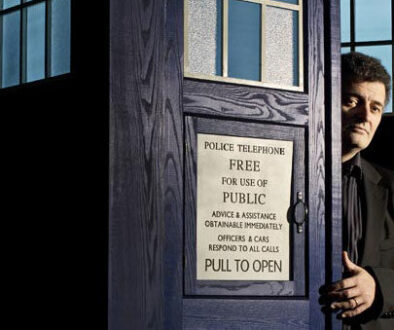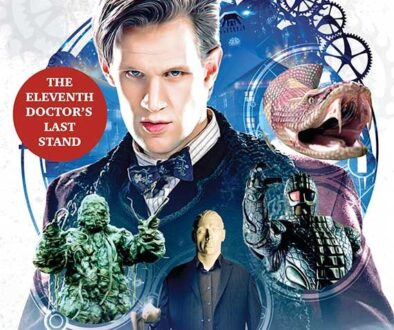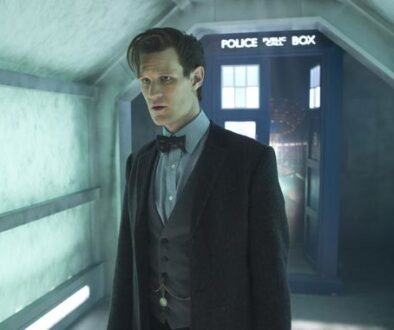The Time of the Doctor Review
Clint Hassell gives his verdict on Matt Smith’s Christmas swansong.

“The Time of the Doctor” is standard Moffat – its script tries to accomplish too much and is poorly-written, but the story is still enjoyable and contains brief moments of brilliance. The episode is not unfixable, and certainly isn’t unwatchable, but falls short as the final story of the Eleventh Doctor’s tenure.
A number of issues derive from the episode’s plot, which attempts to establish a no-win scenario for the Doctor and then demonstrate the best aspects of his character, as he struggles with weighty decisions. Unfortunately, the main crux of the dilemma – that an innocent town would be caught as collateral damage in the crossfire of the ensuing Dalek/Time Lord war – is easily avoided, without the Doctor sacrificing centuries of his final incarnation. Why did the Doctor not relocate the small town’s population to a new settlement, using his bigger-on-the-inside TARDIS? The town is described as a farming community, involving a few hundred people, at most. These villagers seem content to glean their existence from the cold and darkness; how many died in the centuries-long war because the Doctor showed up and forced them into it as their new “sheriff”? Hell, life on Krop Tor would be preferable to hundreds of years of unending war. Perhaps he could have found the human settlement a new planet with a bit more sun?
 While it is poignant that Eleven, the childish Doctor, is forced to grow up and remain settled in one place, the massive amount of time the Doctor spends defending Trenzalore proves problematic as it forces writer Steven Moffat to resort to a throwaway line to explain why Tasha Lem does not similarly age. Further, with 300 years to call for reinforcements, it seems implausible that the Daleks – capable of pulling resources through space and time – have not amassed an armada so large that the Doctor could not possibly forestall their advances on the village. As presented, the various alien races’ attempts to invade Christmas seem more like pranks than serious efforts.
While it is poignant that Eleven, the childish Doctor, is forced to grow up and remain settled in one place, the massive amount of time the Doctor spends defending Trenzalore proves problematic as it forces writer Steven Moffat to resort to a throwaway line to explain why Tasha Lem does not similarly age. Further, with 300 years to call for reinforcements, it seems implausible that the Daleks – capable of pulling resources through space and time – have not amassed an armada so large that the Doctor could not possibly forestall their advances on the village. As presented, the various alien races’ attempts to invade Christmas seem more like pranks than serious efforts.
Another issue in the script of “The Time of the Doctor” is its repetitive structure. The Doctor and Clara literally have five farewell scenes. While the first two are amazing, they are ruined by everything that follows. When I realized that the Doctor had activated a form of Emergency Program One, I gasped, “He just ‘Rose’-d Clara!” and applauded his sensible sacrifice. The second goodbye is the most beautiful, and the most heartbreaking, because “the Doctor lies.” The scene is powerfully acted, Clara’s face a mask of hurt and quiet acceptance. While I still wish that Clara’s jump into the Doctor’s time scar in “The Name of the Doctor” had been her ultimate fate, I would have been very satisfied with this last scene being her character’s exit from the series – it’s so beautifully done.
 . . . So, of course, Moffat has to go and mess it up. Not 68 seconds later, the narrative returns to Clara, already undercutting the dramatic tension created by her loss. A third goodbye is overshadowed as the Doctor appears to be giving up and out of options as he goes to face the Daleks; the fourth by the Doctor’s wild speech as he begins to crackle with cascades of regeneration energy. The final farewell – highlighted by Clara’s tear-filled, “No, no, no!” followed by a whispered, “Please don’t change” – ends abruptly with the appearance of Twelve. At this point, the goodbyes are meaningless, their effects diminished with each successive occurrence.
. . . So, of course, Moffat has to go and mess it up. Not 68 seconds later, the narrative returns to Clara, already undercutting the dramatic tension created by her loss. A third goodbye is overshadowed as the Doctor appears to be giving up and out of options as he goes to face the Daleks; the fourth by the Doctor’s wild speech as he begins to crackle with cascades of regeneration energy. The final farewell – highlighted by Clara’s tear-filled, “No, no, no!” followed by a whispered, “Please don’t change” – ends abruptly with the appearance of Twelve. At this point, the goodbyes are meaningless, their effects diminished with each successive occurrence.
A similar problem occurs when Moffat twists the Doctor’s regeneration sequence into a two-part affair, one as resolution to the Dalek threat, and one to serve as emotional end to Eleven as a character. Like the myriad goodbyes, multiple takes on the regeneration don’t strengthen via a cumulative effect – they divide the pay-off, resulting in an unbelievable plot resolution, and an unfulfilling transition between Eleven and Twelve. A better solution would have been to focus on one regeneration scene and let it play out, restructuring the other scene, as necessary.
 Personally, I found the destruction of the Dalek fleet to be a gross overextension of the effects of regeneration energy (not to mention embarrassingly silly in its execution), so, for me, the preferred fix would have been to have the Time Lords destroy the Dalek fleet directly by, say, having them absorbed and erased from existence by the emergence of the crack in time across the sky, (à la Rory, in “Cold Blood,” or the Weeping Angels, in “Flesh and Stone”). Eleven could then die of old age, in the TARDIS, as presented.
Personally, I found the destruction of the Dalek fleet to be a gross overextension of the effects of regeneration energy (not to mention embarrassingly silly in its execution), so, for me, the preferred fix would have been to have the Time Lords destroy the Dalek fleet directly by, say, having them absorbed and erased from existence by the emergence of the crack in time across the sky, (à la Rory, in “Cold Blood,” or the Weeping Angels, in “Flesh and Stone”). Eleven could then die of old age, in the TARDIS, as presented.
Alternately, if Eleven’s regeneration is what destroys the Daleks, then he should have regenerated into Twelve as a result, on the bell tower, before meeting Clara again. Still want a goodbye with a Matt Smith-looking Doctor? That’s understandable. The episode provided us with one: the holographic suit. Shaken from his ordeal, Twelve could use it to mimic Eleven’s appearance, thus softening the shock to Clara before revealing to her his new form. Having been riddled with regeneration energy, the suit begins to malfunction, allowing the rest of the scene to play out as seen. I was convinced that this was what was happening when Clara entered the TARDIS to find Eleven’s clothes strewn about the console room. Added bonus: having the Doctor hallucinate past companions makes more sense when you consider it a symptom of post-regeneration madness.
 Finally, perhaps the biggest issue with “The Time of the Doctor” is its reliance on long scenes of unwieldy dialogue to convey exposition, i.e., the important background information about characters and events that occurred before the main plot. A great example of effective exposition occurs as the Doctor and Clara experience the force of the truth field for the first time. Not only are the Doctor and Clara’s backstories and personalities quickly summarized for new viewers, the episode-specific concept of the truth field is demonstrated, rather than explained, and it’s accomplished in an entertaining, humorous way. Another good use of exposition is the quick montage that recaps the history of the cracks in the universe and reveals that a crack was in the Doctor’s room in “The God Complex.” The following scene, which substitutes the character of Handles for a quick scan job by the overused sonic screwdriver, shows how neatly everything falls into place regarding the prophecy of the “question that must never, ever be answered.”
Finally, perhaps the biggest issue with “The Time of the Doctor” is its reliance on long scenes of unwieldy dialogue to convey exposition, i.e., the important background information about characters and events that occurred before the main plot. A great example of effective exposition occurs as the Doctor and Clara experience the force of the truth field for the first time. Not only are the Doctor and Clara’s backstories and personalities quickly summarized for new viewers, the episode-specific concept of the truth field is demonstrated, rather than explained, and it’s accomplished in an entertaining, humorous way. Another good use of exposition is the quick montage that recaps the history of the cracks in the universe and reveals that a crack was in the Doctor’s room in “The God Complex.” The following scene, which substitutes the character of Handles for a quick scan job by the overused sonic screwdriver, shows how neatly everything falls into place regarding the prophecy of the “question that must never, ever be answered.”
Unfortunately – save for the current whereabouts of Gallifrey (and despite Moffat’s recent statements to the contrary) – most of the episode’s exposition reveals little about previously unresolved plot threads. It had already been revealed that the Silents were less “evil” and more “misguided in actions, but well-intended in purpose.” We knew that they had blown up the TARDIS in Series 5, and, with Madame Kovarian, engineered River to kill the Doctor, in hopes of preventing the prophecy of the “first question” from being fulfilled. Having this re-explained, in detail, added unnecessarily to the dialogue and serves as proof that Moffat’s machinations may be clever, but they are too reliant on explanation to serve as effective plot devices.
 A better solution might have been to replace the character of Tasha Lem with Kovarian herself, as it is the scenes with Lem that suffer most from unnecessary exposition. By not having to introduce a new character, the episode could’ve devoted additional screen time to fleshing out explanations of previous events in a more organic way. As it stands, Lem has to explain the actions of Kovarian, a character unseen on the show in over two years. (That’s a plot thread I like to see resolved: what became of Kovarian after “A Good Man Goes to War”?)
A better solution might have been to replace the character of Tasha Lem with Kovarian herself, as it is the scenes with Lem that suffer most from unnecessary exposition. By not having to introduce a new character, the episode could’ve devoted additional screen time to fleshing out explanations of previous events in a more organic way. As it stands, Lem has to explain the actions of Kovarian, a character unseen on the show in over two years. (That’s a plot thread I like to see resolved: what became of Kovarian after “A Good Man Goes to War”?)
Ironically, for an episode too heavy with exposition, Clara’s one-sided conversation with the Time Lords on Gallifrey is missing the necessary lines to truly make the plot work; thus, the episode doesn’t have enough exposition either. In the scene, Clara ostensibly confirms the Doctor’s identity, which theoretically should have resulted in the Time Lords bursting forth into this universe. A reason needed to be given for them to not, something like: “It’s not safe for you here. Daleks lie in ambush and the Doctor has sacrificed the last of his lives protecting you. Please help him, now, so that he can continue to find a safe way to return you to this universe, when the time is right.” This not only would provide adequate reason for the Time Lords to seal their escape crack as shown, but it gives them impetus to gift the Doctor with a new regeneration cycle, and even to defeat the Daleks, as previously suggested. As it stands, Clara’s speech may be one of the more impassioned in recent memory, but it is seemingly short on story logic – something that could also be said of “The Time of the Doctor” as a whole.








